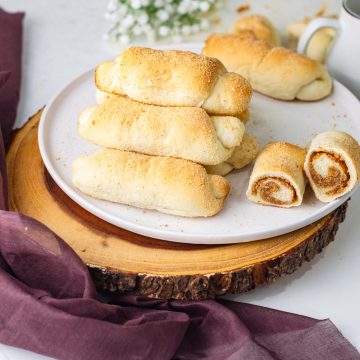
Spanish Bread
If you've ever enjoyed the deliciously soft and fluffy Spanish bread from a Filipino bakery, you know how irresistible these sweet rolls can be. Filled with a buttery, sugary filling and coated in breadcrumbs, Filipino Spanish bread—also known as Señorita bread—is a beloved treat among fans of Spanish sweet breads and classic Filipino pastries.
Ingredients
Dough ingredients
- 300 g Bread flour 2 cups
- 42 g Sugar 3 Tbsp
- 3 g Salt ½ tsp
- 42 g Butter 3 Tbsp
- 200 g Water about ¾ cup
Filling Ingredients
- 42 g Butter 3 tbsp
- 62 g Bread crumbs Plain
- 10 g Flour 1tbsp
- 45 g Brown sugar ¼ cup
- 2 tablespoon Whole milk
- A pinch of salt
- ½ cup Plain bread crumbs for coating
Instructions
Combine the ingredients:
- In a large bowl, combine bread flour, sugar, salt, and instant yeast.
- If using active dry yeast, dissolve it in warm water with a little sugar and let it sit until frothy.
- Add water and mix until a shaggy dough forms.
Knead the Dough:
- By Hand: Knead on a floured surface, adding softened butter gradually until incorporated. Knead for 12-15 minutes until smooth and elastic.
- Using a Stand Mixer: Knead with a dough hook, adding butter gradually. Mix for 8-10 minutes until the dough pulls away from the bowl.
- Perform the windowpane test and shape the dough into a ball.
First Rise (Bulk Fermentation):
- Place dough in a greased bowl, cover, and let it rise in a warm place for 1-2 hours until doubled in size.
- Use the "poke test" to check readiness—if the indentation springs back slowly, it's ready.
Make the Filling:
- Melt butter in a saucepan, then add flour and cook fro 2 minutes at low heat. Then add breadcrumbs, brown sugar, salt, and milk.
- Stir and cook until thickened, then let it cool completely.
Shape the Bread:
- Punch down the risen dough and divide it into 10 equal pieces.
- Roll each into a smooth ball, rest for 15 minutes, then flatten into an oval shape. Then use your hands to stretch and make one side wide.
- Spread filling on each piece, leaving edges clear, then roll into a log.
- Coat with breadcrumbs and place seam-side down on a baking sheet.
Bake the Bread:
- Preheat oven to 375°F (190°C).
- Bake for 15 minutes or until golden brown.
- Let cool slightly and enjoy warm!
Notes
- For Detailed instructions refer to the blog post.
- Make sure your instant yeast is fresh and not expired. Because unlike active dry yeast there is no additional step of blooming to confirm that.
- Don’t spread the filling too close to the edges—leave about ½ inch border to prevent it from oozing out.
- If the Bread Turns Out Too Dense, this could be due to too much flour or not enough kneading. The dough should be soft and elastic. Also, allow enough time for the dough to rise properly before baking for a light, fluffy texture.
- Swap bread flour with all-purpose flour, but since all-purpose flour absorbs less liquid, reduce the amount of water or milk in the dough by about 10% to maintain the right consistency.
- Substitute butter and milk with vegan substitutes for making Vegan Spanish Bread.
Nutrition Facts

Nutrition
Calories: 237kcal
Tried this recipe?Let us know how it was!